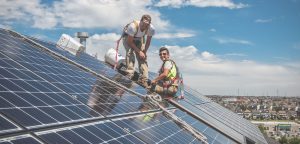Besides the Obvious Environmental Benefits, Green Firms Now See Profitability as an Added Attraction

Green-focused, environmentally-based companies are more and more in demand and growing
VICTORIA – Before environmental issues became front and centre, there wasn’t much of a business case to be made for most companies to view efforts to “go green” as worth their while.
If someone could “make garbage pay”, then that could become an opportunity to realize profits from reducing, re-using and re-cycling.
That day has surely come, as green-focused, environmentally-based companies are doing well and growing.
Business owners and entrepreneurs have recognized that consumers do, in many cases, make their buying decisions based on the environmental policies and efforts of companies. They just feel better about their purchases, knowing that the company they’re dealing with views the environment similarly to the way they do.
Thus the necessity of including a company’s environmental pursuits and successes has become an integral part of marketing. It is important that businesses let the world know what they’re doing to keep Canada green and healthy, and of any efforts made to reduce the amount of green-house gases and materials that would normally end up in landfills.
Garbage has become big business. Waste Management Inc., for example, has 58 locations in BC, and does much more than garbage pickup, offering residential, commercial and industrial waste management, along with recycling and e-waste solutions. It is now the largest waste management company in North America.
It’s share price on the New York Stock Exchange? $164.20 U.S. as of June 15, or $217.35 Canadian. That’s over double the cost of shares in mid-2018.
In the Pushor Mitchell LLP Thompson Okanagan Business Excellence Awards held June 6 in Kelowna, the Big Business of the Year was Pela + Lomi.

A Lomi unit, at work, on a countertop in the home
Their parent company started in Saskatchewan in 2007 after a family trip to Hawaii, where they decided to do something about plastic waste. Their first product was a compostable phone case made from a proprietary material they call Flaxstic, a polymer made from a combination of bioplastic and flax shive waste.
In 2021 they launched Lomi, a kitchen countertop composting unit that is now found in over 140,000 households. They are on a mission to eliminate 10 billion pounds of waste per year by 2028. Now with their Kelowna Sustainability Studio, where 65 per cent of their manufacturing is now done, they have capacity to produce 12,000 units per week.
They also have other products in what is referred to as a “Smart Waste Economy”, which operates on three principles, Prevent, Process and Produce: Lomi Dirt, Lomi consumables, Lomi pods (composting catalysts).
Revenues have grown almost 300 percent, and it is now a $12 million a year company.
Governments have certainly noticed, and the 2023 federal budget allocated over $70 billion in funding for clean energy projects.
This includes the development of renewable energy generation projects and renewable energy infrastructure upgrades.
The City of Victoria has joined with other cities across the globe in starting a transition to renewable energy. This process will be gradual and take many years, and solar energy has a role to play.
Today, large-scale solar power projects are being built to deliver electricity at less than 8c/kWh.
While residential and commercial building based solar projects in Victoria don’t currently produce electricity at these rates, it is anticipated that grid parity – a state where rooftop generated solar electricity can be generated at the same cost as purchasing from the BC Hydro grid – will occur in the near future. In the meantime, solar panels can be an attractive option for those wishing to generate their own clean renewable power.
If saving energy or reducing greenhouse gas emissions is a priority, then for the majority of building and home owners simple steps such as air sealing and additional insulation are going to be the most cost-effective first steps.
The information is available on the website: https://www.victoria.ca/EN/main/residents/climate-action.html
Victoria-based Shift has introduced Roofit.Solar to Canada, which makes the entire roof a solar unit, and features integrated photovoltaics for commercial and residential installations.
Roofit.Solar by Shift looks like a sleek black metal roof, but the 2-in-1 design integrates high output solar cells, with a lifetime grade roofing material, and the roof produces its own power.
“We believe BIPV is the future of solar. Every new home constructed should include a means of power generation and storage,” says Shift President Colyn Strong. “We’ve tested it in our climate and are confident it is the right product for Canadians, which is why I installed it on my house. We are so excited to now be offering it to homeowners and building developers in BC and Nova Scotia.”

According to Skyfire Energy, solar power makes good business sense. Generating solar power to offset your electricity use from the grid reduces your operational costs and saves you money. Excess electricity produced is exported to the grid for a credit against future electricity use. @skyfireenergy.com
Sky Fire Energy Kelowna is informing the marketplace that there is something called a Clean Technology Investment Tax Credit, which is a 30 per cent refundable tax credit on the cost of investments in solar and other renewable energies. The credit is applicable for all taxable entities: personal, business, corporations, trusts and international and non-resident income. It is available until 2034 and is expected to cost over $11 billion.
The federal budget also includes a refundable 15 per cent tax credit through the Clean Electricity Investment Tax Credit, which would assist with investments made by Indigenous communities, municipalities and crown corporations. There is also funding available for the development of renewable energy infrastructure for transmission lines, energy storage facilities, and supporting clean energy projects across the country.
Business Examiner Staff

